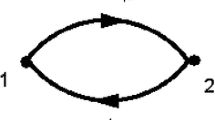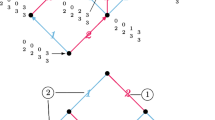Abstract
It is conjectured that the Kashiwara-Vergne Lie algebra \(\widehat{\mathfrak {krv}}_2\) is isomorphic to the direct sum of the Grothendieck-Teichmüller Lie algebra \(\mathfrak {grt}_1\) and a one-dimensional Lie algebra. In this paper, we use the graph complex of internally connected graphs to define a nested sequence of Lie subalgebras of \(\widehat{\mathfrak {krv}}_2\) whose intersection is \(\mathfrak {grt}_1\), thus giving a way to interpolate between these two Lie algebras.




Similar content being viewed by others
References
Alekseev, A., Torossian, C.: The Kashiwara-Vergne conjecture and Drinfeld’s associators. Ann. Math. 172(2), 415–463 (2012)
Conant, J., Gerlits, F., Vogtmann, K.: Cut vertices in commutative graphs. Q. J. Math. 56(3), 321–336 (2005)
Dolgushev, V.A., Rogers, C.L.: Notes on algebraic operads, graph complexes, and Willwacher’s construction. In: Evens, S., Gekhtman, M., Hall, B.C., Liu, X., Polini, C. (eds.) Mathematical Aspects of Quantization: Center for Mathematics at Notre Dame, Summer School and Conference, Notre Dame University, Notre Dame, Indiana, May 31–June 10 2011. Contemporary Mathematics, vol. 583. American Mathematical Society, Providence (2011)
Drinfeld, V.G.: On quasitriangular quasi-Hopf algebras and on a group that is closely connected with \({\rm Gal}(\overline{{\bf Q}}/{\bf Q})\). Leningrad Math. J. 2(4), 829–860 (1991)
Kashiwara, M., Vergne, M.: The Campbell-Hausdorff formula and invariant hyperfunctions. Invent. Math. 47(3), 249–272 (1978)
Kontsevich, M.: Formal (non)commutative symplectic geometry. The Gel\(\prime \)fand Mathematical Seminars, 1990–1992, pp. 173–187. Birkhäuser Boston, Boston (1993)
Kontsevich, M.: Feynman diagrams and low-dimensional topology. In: Joseph, A., Mignot, F., Murat, F., Prum, B., Rentschler, R. (eds.) First European Congress of Mathematics, Paris, 6–10 July 1992. Progress in Mathematics, vol. 120. Birkhäuser, Basel (1994)
Kontsevich, M.: Formality conjecture. In: Deformation theory and symplectic geometry (Ascona, 1996), volume 20 of Math. Phys. Stud. pp. 139–156. Kluwer Acadmic Publication, Dordrecht (1997)
Kontsevich, M.: Operads and motives in deformation quantization. Lett. Math. Phys. 48(1), 35–72 (1999)
Lambrechts, P., Volić, I.: Formality of the little \(N\)-disks operad. Mem. Amer. Math. Soc. 230(1079), viii+116 (2014)
Loday, J.L., Vallette, B.: Algebraic Operads. Grundlehren der mathematischen Wissenschaften. Springer, Berlin (2012)
Tamarkin, D.E.: Another proof of M. Kontsevich formality theorem, ArXiv Mathematics e-prints (1998)
Ševera, P., Willwacher, T.: Equivalence of formalities of the little discs operad. Duke Math. J. 160(1), 175–206 (2011)
Vallette, B.: Algebra + homotopy = operad. In: Symplectic, Poisson, and noncommutative geometry, volume 62 of Math. Sci. Res. Inst. Publ. pp. 229–290. Cambridge University Press, New York (2014)
Weibel, C.A.: An Introduction to Homological Algebra. Cambridge Studies in Advanced Mathematics. Cambridge University Press, Cambridge (1995)
Willwacher, T.: M. Kontsevich’s graph complex and the Grothendieck-Teichmüller Lie algebra. Invent. Math. 200(3), 671–760 (2014)
Acknowledgements
The author is highly indebted and very thankful to his advisor Thomas Willwacher for patiently explaining most of the material presented in this text to him. He is grateful to Anton Alekseev for his constant support and numerous useful discussions. He would also like to thank Ricardo Campos, Florian Naef and Elise Raphael for many fruitful exchanges. The author was supported by the grant MODFLAT of the European Research Council (ERC).
Author information
Authors and Affiliations
Corresponding author
Appendix A. The spaces \({\mathfrak {t}}{\mathfrak {r}}_n,\mathfrak {sder}_n,\mathfrak {tder}_n\)
Appendix A. The spaces \({\mathfrak {t}}{\mathfrak {r}}_n,\mathfrak {sder}_n,\mathfrak {tder}_n\)
We follow [1]. Fix \(n\ge 1\). Let \(\mathfrak {lie}_n\) denote the completed free Lie algebra over \({\mathbb {K}}\) on n variables \(x_1,\ldots ,x_n\) and let \(\text {Ass}_n=U(\mathfrak {lie}_n)\) be the completed free associative algebra in n generators. The graded vector space of cyclic words in n variables \({\mathfrak {t}}{\mathfrak {r}}_n\) is defined as
where \(\text {Ass}_n^+\) is the augmentation ideal of \(\text {Ass}_n\). The Lie algebra \(\mathfrak {tder}_n\) of tangential derivations on \(\mathfrak {lie}_n\) is defined as follows. A derivation u on \(\mathfrak {lie}_n\) is tangential if there exist \(a_1,\ldots ,a_n\in \mathfrak {lie}_n\) such that \(u(x_i)=[x_i,a_i]\) for all \(i=1,\ldots ,n\). The action of u on the generators completely determine the derivation. For \(u=(a_1,\ldots ,a_n)\) and \(v=(b_1,\ldots ,b_n)\) elements of \(\mathfrak {tder}_n\), the Lie bracket is the tangential derivation \([u,v]=(c_1,\ldots ,c_n)\), where \(c_k=u(b_k)-v(a_k)+[a_k,b_k]\) for all \(k=1,\ldots ,n\). The Lie algebra of special derivations \(\mathfrak {sder}_n\) is
It is a Lie subalgebra of \(\mathfrak {tder}_n\). For every \(a\in \text {Ass}_n\), we have a unique decomposition
where \(a_0\in \mathbb {K}\) and \((\partial _k a)\in \text {Ass}_n\). The divergence map
is a cocycle for \(\mathfrak {tder}_n\) ([1], Proposition 3.6.).
The following algorithm describes the isomorphism between \(H^0(\hat{gr}\mathsf {ICG}(n)^0,d_0)\), i.e., internally trivalent trees in \(\mathsf {ICG}(n)\) modulo IHX, and \(\mathfrak {sder}_n\). Let \(\Gamma \) be a tree representing an element of \(H^0(\hat{gr}\mathsf {ICG}(n)^0,d_0)\). Pick an edge incident to the external vertex 1, cut it and make it the “root” edge. The resulting tree is a binary tree with leafs labeled by \(1,\ldots , n\). Repeat this procedure for every edge incident to vertex 1, and take the sum of the trees obtained in this way. We want to interpret these binary trees as Lie words. The sign convention for this is as follows. The edges of the tree should be ordered such that its “root” edge comes first, then all edges of its left subtree, and then all edges of its right subtree. For each subtree, apply this convention recursively. The resulting linear combination of Lie words (these can be read off the trees by following the ordering of the edges) in the variables \(x_1,\ldots ,x_n\) corresponds to the first component \(a_1\) of a special derivation \(a=(a_1,\ldots ,a_n)\in \mathfrak {sder}_n\). The ith component \(a_i\) is obtained by applying the same procedure to the ith external vertex (Fig. 5).
We now give the map \(H^1(\hat{gr}\mathsf {ICG}(n)^1,d_0)\hookrightarrow {\mathfrak {t}}{\mathfrak {r}}_n\) as described in [13]. Let \(\overline{\Gamma }\in H^1(\hat{gr}\mathsf {ICG}(n)^1,d_0)\). We may assume that the representative \(\Gamma \) is such that the loop passes through all internal vertices. Order the edges as in Fig. 6. In this case, we map
Rights and permissions
About this article
Cite this article
Felder, M. Internally connected graphs and the Kashiwara-Vergne Lie algebra. Lett Math Phys 108, 1407–1441 (2018). https://doi.org/10.1007/s11005-018-1052-5
Received:
Revised:
Accepted:
Published:
Issue Date:
DOI: https://doi.org/10.1007/s11005-018-1052-5






